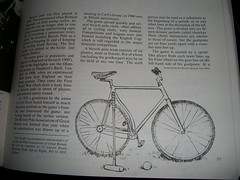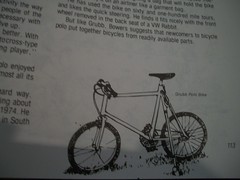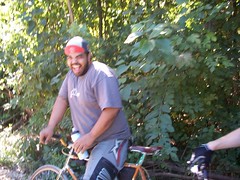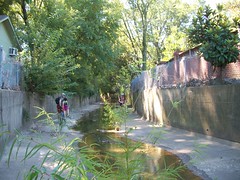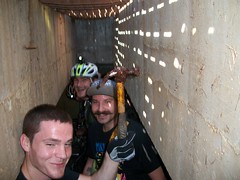Marx and Bensdorf has a cross race on the TBRA schedule entitled Spooky Cross, set to take place October 30th and 31st.
I haven't found a flyer for it yet and I'm assuming it's not associated with the Spooky Cross on Facebook.
More details when we see them...
Thursday, September 30, 2010
Friday, September 24, 2010
Tuesday, September 21, 2010
Worst of Craigslist: Sexual Favors?
This person, at first glance, seems to be willing to trade some form of intimate relations for a bicycle of equal value. At $1000 it must be quite a position. I don't even know what a Frenchi over/under is but it sounds quite satisfying and maybe slightly acrobatic.
Alas, after some Googling I think the person meant Franchi Over/Under, as in an antique shotgun.
Sex or guns? Insert your own euphemisms in the comments section.
Alas, after some Googling I think the person meant Franchi Over/Under, as in an antique shotgun.
Sex or guns? Insert your own euphemisms in the comments section.
Surly in TECHNICOLOR!
I had mine powdercoated from that maroon color to black about 2 years before they started offering the Steamroller in black or white (The Creamroller). Through its many incarnations (street track, track track, yes I had a white Aerospoke, and now SSCX) it's been black and yes, my beast of a machine is staying black. I was even considering a Cross-Check in black until I spotted this one on Prolly:

I know, right. Following all of the links over to Blue Lug you can see some very colorful Steamroller frames as well. One example (such a tight blue):

Apparently these are all custom jobbies and the only way you can get that in the States is if you pay 77,700 Yen plus shipping. That comes out to about $905 and I know from experience that shipping a frame to Japan costs about $300. Provided that's the same as Japan to America you're buying a frame for more than the cost of a complete bike that you could have broken down and powdercoated all at home. And the real killer is they don't even have one in my size!
So I thought to myself, "Interbike is this week. I wonder what Surly will show?" So I rode over to their blog and behold: Oh, what the hell...
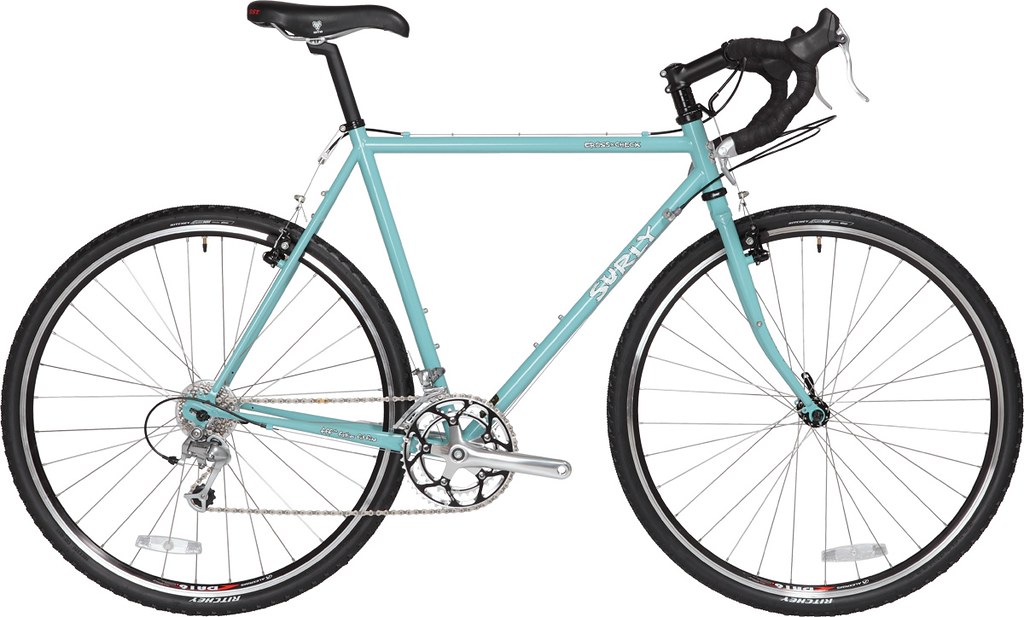
OF course I would like one of everything that Surly offers, especially a Pugsley (wtf would I do with one in Memphis, though?) but I'm thoroughly satisfied with the Robin's Egg Blue on the Cross-Check. Available in November so that gives me time to get a Rival kit together and get rid of my Trek and those bar-end shifters and caliper brakes! Six-hunny gets you Dura-Ace bar-end shifters, 10spd 105 rear derailleur, Campy brakes and crankset, wireless computer. Sorry, trailer, rear rack, trunk bag, seat bag, pedals not included.
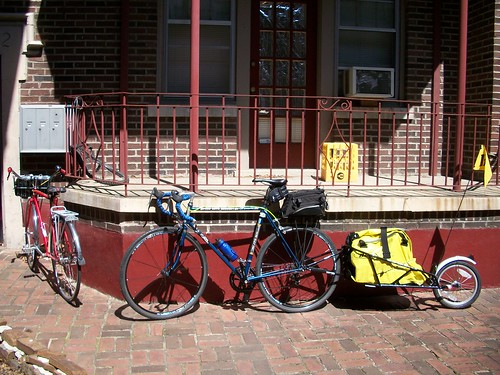

I know, right. Following all of the links over to Blue Lug you can see some very colorful Steamroller frames as well. One example (such a tight blue):

Apparently these are all custom jobbies and the only way you can get that in the States is if you pay 77,700 Yen plus shipping. That comes out to about $905 and I know from experience that shipping a frame to Japan costs about $300. Provided that's the same as Japan to America you're buying a frame for more than the cost of a complete bike that you could have broken down and powdercoated all at home. And the real killer is they don't even have one in my size!
So I thought to myself, "Interbike is this week. I wonder what Surly will show?" So I rode over to their blog and behold: Oh, what the hell...

OF course I would like one of everything that Surly offers, especially a Pugsley (wtf would I do with one in Memphis, though?) but I'm thoroughly satisfied with the Robin's Egg Blue on the Cross-Check. Available in November so that gives me time to get a Rival kit together and get rid of my Trek and those bar-end shifters and caliper brakes! Six-hunny gets you Dura-Ace bar-end shifters, 10spd 105 rear derailleur, Campy brakes and crankset, wireless computer. Sorry, trailer, rear rack, trunk bag, seat bag, pedals not included.

Ditch Ride: Event Horizon
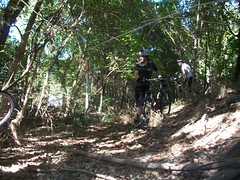
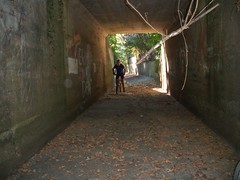
From the same entry point as our previous ditch ride we decided to take off in the opposite direction. While we were still ducking and dodging overhanging branches and broken glass there was a lot more room to navigate. It was also apparent that this part of the ditch saw a lot more action.

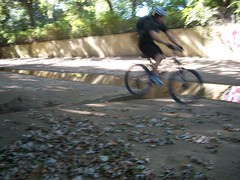

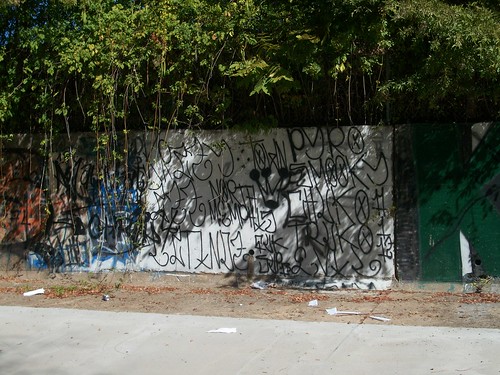
At about this point we found several exits: one led up to some railroad tracks and was labeled North Nut Bush and the other, well, let's just say that we rolled up on a guy making an exit of his own. Needless to say we kept riding. Unfortunately, not for very long. My considerations for titles of this post included "Where the Sidewalk Ends." A portentous bit of greenery ahead marked the turning back point of this ride.
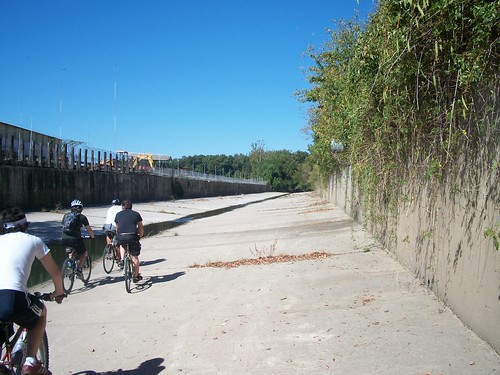
Scores for this ride: golf ball, composition book with gossip, and a Frisbee golf disc. There was one split that I would like to explore sometime before it gets too cold. Just keep checking back and hopefully you'll join us when it happens.
More pictures of graffiti and shenanigans are on my flickr
Wednesday, September 15, 2010
New Light Means New Ditch Ride
I just got a Light & Motion Stella 120. It may be entry level, but entry level for Light & Motion is magnitudes beyond everything else. Over the years I have spent well beyond the retail cost of the Stella 120 ($130), only to be disappointed in the product (Knog, your design is great but I've had so many functional problems!) so I decided to throw down and invest in lumens, rechargeable battery, and compactness all in one package.

It's so good you might think I'm a car coming up behind you! This light is already shining through the nights and will definitely see an insane number of commutes this fall/winter.
If you'd like to see it in action meet up at my place (tentative) this Sunday at 9am for another urban exploration adventure.

It's so good you might think I'm a car coming up behind you! This light is already shining through the nights and will definitely see an insane number of commutes this fall/winter.
If you'd like to see it in action meet up at my place (tentative) this Sunday at 9am for another urban exploration adventure.
British Bicycle Polo vs American Bicycle Polo
These essays both appear in The Bicycling Book. Both describe a bicycle polo played on a grass field, not a hard court. And this was printed in 1982.
British Bicycle Polo
Tony Knight
Bicycle Polo was first played in 1891. The sport started when Richard Mecredi, an Irish racing cyclist, decided he was no longer able to continue competing, and not being capable of accepting a premature retirement, he invented Bicycle Polo as a means of keeping fit and of keeping his cycling blood flowing. The first game was played at the Scalp, just outside Dublin.
The game grew in popularity and spread to England in the early 1900's. One of the highlights was the Olympic games at Shepherd's Bush, London, in 1908, when an experienced Irish team beat England on their home ground. Then came the First World War which dealt a body blow to bicycle polo in terms of players and interest slowly waned.
In 1930 a gentleman by the name of Cyril Scott found himself in much the same position as the game's founder and reinvented the game, not having heard of the earlier version. The Bicycle Polo Association of Great Britain was formed that year when the constitution was drawn up at a meeting at Cyril's house, so 1980 sees its fiftieth anniversary.
The game spread quickly and several bicycle polo clubs, often affiliated to cycling clubs, were formed. Competitions and leagues were also formed including the English Cup, which is still regarded as the major domestic competition.
A bicycle polo team consists of six players, male or female, five of whom (including the goalkeeper) may be on the field at any one time. The sixth person may be used as a substitute at the beginning of a period, or at any other time at the discretion of the referee. The fame is divided into six fifteen-minute periods called chukkas. Pitch (field) dimensions are similar to those of soccer, but the goalposts are set four yards apart with a crossbar nine feet up.
The game is started by a sprint. One player from each team lines up his front wheel on the goal line on the left hand side of his goalposts. At a signal from the referee each races toward the center spot to gain possession of the ball. The best way to "trap" the ball is to use the wheels but it can be stopped by any part of the body to bring it under control. The ball may be struck in any direction but not while the player is dismounted (one foot on the ground is deemed dismounted). You may not catch or throw the ball but it is permissible to use the hand to stop or knock it; you may kick it as well, but only when it is airborne. Although play can be robust it is not dangerous. It is very rare for a player to receive an injury worse than a minor bruise or two, yet players are allowed to shoulder charge, tackle, crook a mallet, or "ride off" an opponent challenging for the ball.
Once a player graduates from the initial stage he begins to learn the finer points: stroke-play, bike handling, and team tactics. It is a delight to watch two top teams in action - the high-speed interpassing and clever "practiced" attacks with the resultant abundance of shots. The referee (who, incidentally, is on foot) is usually assisted by two goal judges and two linesmen - necessary because of the fast pace of the sport.The bicycle, which may be bought either new or built up at relatively low cost from spare parts must conform to safety regulations laid down by the association. For instance, the handlebars are kept quite short, and brakes and metal pedals are forbidden because of the danger of cuts. The main conversion from a standard bike is the fixed wheel. I started my polo career on such a crude conversion. In fact, my first ever experience of polo was on a grocery delivery bike, complete with basket! The gearing is on the low side - this helps to get maximum acceleration and speed over minimum distance, which of course makes the game faster and more exciting. The wheels are usually twenty-six inches in diameter and one and three-eighths inches across the rim. A normal tire is used in front, but a special spud tire is used in the rear.
The mallet must be held in the right hand and can be either thirty-two or thirty-four inches long, with a head of either four or seven inches. Wrist straps are not allowed, and metal must not be incorporated into the head, although this does not apply to the shaft.
The ball has a diameter of three and a quarter inches and is usually made of bamboo. In recent years, limited success has been experienced with a plastic version that tends to last several games, as opposed to the bamboo counterpart which usually needs replacing every fifteen minutes.
Tony Knight is a competitor and secretary of the Bicycle Polo Association of Great Britain. He can be reached at 72 Upton Road, Haylands, Ryde, Isle of Wight, PO 33 3HX, England
American Bicycle Polo
Walter K. Ezell
"Bicycle Polo fills a gap in cycling," says Richard Grubb of the United States Bicycle Polo Association. "You don't have to be in super shape to enjoy it, so it fills the gap between touring and racing, a sport you can do on a bicycle the you don't have to spend ten hours a day practicing.
"There are plenty of cyclists who will go out and play softball on the weekends and later ride their bike. Bicycle polo enables them to 'play softball' and ride their bikes at the same time."
With four teams and a twelve-game season, Charlotte, North Carolina, probably has the most bicycle polo activity in the United States. There are also teams in Chicago, Wisconsin, California, and possibly Colorado. There is also some interest in starting teams in Oklahoma and Minnesota, according to Grubb.
In 1897 in Milton, Massachusetts, a bicycle polo club was formed, but with the decline in popularity of the bicycle in the early twentieth century, the sport lost ground in the United States. It has experienced several faddish revivals since, but has never gained a strong footing.
Bicycle polo has been described as the "poor man's polo," though the bicycle polo enthusiast can spend five hundred dollars on equipment if he wants to do it the deluxe way. The sport greatly resembles horse polo, and some people play both sports. But just as field hockey and ice hockey have developed some basic differences, so have bicycle and horse polo.
The field is one third the size of the horse polo field, with maximum dimensions of 140 by 60 yards, the same as a football field. There is a goal at each end of the field, marked by posts twelve feet apart. A point is scored when a player knocks the ball between the goalposts of the opposing team.
Because of the reduced size of the field the player may only hit the ball three times in a row, while the horse polo player is allowed an unlimited number of hits. As a result, team play is important, with passing patterns to move the ball down the field.
Bicycle polo is also much less of a contact sport than horse polo, with "riding off" forbidden. Riding off allows an equestrian player to bump into an opponent, preventing him from lining up the shot correctly. But since bicycles don't have the resiliency of horses, contact is more hazardous and is not allowed.
Polo ponies are trained to follow the ball. "When horse polo players play bicycle polo," says Grubb, "it takes a while for them to get used to the fact that their 'horse' doesn't just take off after the ball."
Who plays bicycle polo? John Bowers, chairman of the Charlotte Bicycle Polo League, says that no more than twenty-five percent are avid bicycle riders. "Bicycle riders are about the last people to take it seriously, because almost all other phases of bicycle sport are actually solitary. Even though bike racing has teams, their tactics are not equal to the kind of teamwork required to win a polo match.
"Very few sports lend themselves to family activity the way this one does. Most are involved with matching people of the same ages, but that hasn't proved to be necessary with bicycle polo. It is good for all ages, from about twelve up.
"The younger one starts to learn this game the better. With handlebar modifications, the small scrambler or motocross-type bike that most kids ride would be ideal for the young player," Bowers said.
In the Northeast United States, where bicycle polo enjoyed passing popularity a few years ago, the sport drew almost all its players from the ranks of horse polo players.
But the Charlotte players learned the sport the hard way. John Bowers became interested in the game after reading about it in the League of American Wheelmen magazine in 1974. He and others studied the rules, went to a horse polo match in South Carolina, and learned by doing.
Their first encounter with other players was at a tournament last year in Chicago - which they won. "We learned a lot," says Bowers. "Having now had the experience of playing against Bill Matheson's team of horse polo players on bikes, I feel that our emphasis on the bicycle equipment was somewhat misplaced. The name of the game is stick skill and play anticipation. The bicycle itself can definitely help or hurt one's game, but can never compensate for lack of skill and knowledge of play."
Bowers says September through November is a good time for the season, because other bicycling activities are tapering off. "It is a good cold-weather sport. You generate a certain amount of heat."
Grubb advised starting out with inexpensive bicycles. "Get a twenty-six-inch wheel coaster brake bike with a drop frame, straighten the front forks, and substitute a twenty-four-inch front wheel. Slice the handlebars down. Remember, the less bike the better. Inevitably you are going to fall, and you don't want protruding parts or a high top tube to hurt you or another player."
The mallets and balls and often the helmets used in horse polo are also used in bicycle polo, and it is therefore not too difficult to get these items.
But the polo helmets are expensive - retailing and fifty to seventy dollars. Bicycle helmets are not adequate as they lack crucial face protection. The teams in Charlotte and Chicago use construction helmets with clear Lexan face protectors added.
Grubb used to build polo bikes of his own design one at a time, till his physician told him the fumes from brazing were causing lung problems. Bowers bought about a dozen of the frames from Grubb, and still owns nine. He rents them to players on a per-game basis to cover maintenance costs.Because of the short forks which fit the twenty-inch wheels, the steering tube is unusually long. Compared to a motocross bike the Grubb polo bikes have a shorter wheelbase and a longer trail - two and a half inches.
The bikes are light - twenty or twenty-one pounds. And strong? Grubb claims one "took the door off a taxi and only bent one of the front forks." (The rider suffered a broken collarbone and the woman in the taxi became hysterical.)
Some of the Chicago players including Grubb used a fixed gear - like track bikes use. Others us a coaster brake or disc brake, sometimes in combination with a front caliper brake.
Professionally Bowers in an industrial designer. He likes to polo bike design so much he has no other kind of frame. He has set up one of his frames as a touring bike with a six-speed free-wheel. He is working on designing a bag that will hold the bike so he can carry it on an airliner like a garment bag.
He has used the bike on sixty and one-hundred mile tours, and likes the quick steering. He finds it fits nicely with the front wheel removed in the back seat of a VW Rabbit.
But like Grubb, Bowers suggests that newcomers to bicycle polo put together bicycles from readily available parts.
Walter Ezell reports on all phases of the cycling scene for the LAW Bulletin, of which he is editor. He also contributed the plea for cyclists' right to the road, "You Can't Get There from Here."
Krausz, John and Vera van der Reis Krausz. "The Bicycling Book: Transportation, Recreation, Sport" The Dial Press. 1 Dag Hammarskjold Plaza. New York, New York 10017. 1982
British Bicycle Polo
Tony Knight
Bicycle Polo was first played in 1891. The sport started when Richard Mecredi, an Irish racing cyclist, decided he was no longer able to continue competing, and not being capable of accepting a premature retirement, he invented Bicycle Polo as a means of keeping fit and of keeping his cycling blood flowing. The first game was played at the Scalp, just outside Dublin.
The game grew in popularity and spread to England in the early 1900's. One of the highlights was the Olympic games at Shepherd's Bush, London, in 1908, when an experienced Irish team beat England on their home ground. Then came the First World War which dealt a body blow to bicycle polo in terms of players and interest slowly waned.
In 1930 a gentleman by the name of Cyril Scott found himself in much the same position as the game's founder and reinvented the game, not having heard of the earlier version. The Bicycle Polo Association of Great Britain was formed that year when the constitution was drawn up at a meeting at Cyril's house, so 1980 sees its fiftieth anniversary.
The game spread quickly and several bicycle polo clubs, often affiliated to cycling clubs, were formed. Competitions and leagues were also formed including the English Cup, which is still regarded as the major domestic competition.
A bicycle polo team consists of six players, male or female, five of whom (including the goalkeeper) may be on the field at any one time. The sixth person may be used as a substitute at the beginning of a period, or at any other time at the discretion of the referee. The fame is divided into six fifteen-minute periods called chukkas. Pitch (field) dimensions are similar to those of soccer, but the goalposts are set four yards apart with a crossbar nine feet up.
The game is started by a sprint. One player from each team lines up his front wheel on the goal line on the left hand side of his goalposts. At a signal from the referee each races toward the center spot to gain possession of the ball. The best way to "trap" the ball is to use the wheels but it can be stopped by any part of the body to bring it under control. The ball may be struck in any direction but not while the player is dismounted (one foot on the ground is deemed dismounted). You may not catch or throw the ball but it is permissible to use the hand to stop or knock it; you may kick it as well, but only when it is airborne. Although play can be robust it is not dangerous. It is very rare for a player to receive an injury worse than a minor bruise or two, yet players are allowed to shoulder charge, tackle, crook a mallet, or "ride off" an opponent challenging for the ball.
Once a player graduates from the initial stage he begins to learn the finer points: stroke-play, bike handling, and team tactics. It is a delight to watch two top teams in action - the high-speed interpassing and clever "practiced" attacks with the resultant abundance of shots. The referee (who, incidentally, is on foot) is usually assisted by two goal judges and two linesmen - necessary because of the fast pace of the sport.The bicycle, which may be bought either new or built up at relatively low cost from spare parts must conform to safety regulations laid down by the association. For instance, the handlebars are kept quite short, and brakes and metal pedals are forbidden because of the danger of cuts. The main conversion from a standard bike is the fixed wheel. I started my polo career on such a crude conversion. In fact, my first ever experience of polo was on a grocery delivery bike, complete with basket! The gearing is on the low side - this helps to get maximum acceleration and speed over minimum distance, which of course makes the game faster and more exciting. The wheels are usually twenty-six inches in diameter and one and three-eighths inches across the rim. A normal tire is used in front, but a special spud tire is used in the rear.
The mallet must be held in the right hand and can be either thirty-two or thirty-four inches long, with a head of either four or seven inches. Wrist straps are not allowed, and metal must not be incorporated into the head, although this does not apply to the shaft.
The ball has a diameter of three and a quarter inches and is usually made of bamboo. In recent years, limited success has been experienced with a plastic version that tends to last several games, as opposed to the bamboo counterpart which usually needs replacing every fifteen minutes.
Tony Knight is a competitor and secretary of the Bicycle Polo Association of Great Britain. He can be reached at 72 Upton Road, Haylands, Ryde, Isle of Wight, PO 33 3HX, England
American Bicycle Polo
Walter K. Ezell
"Bicycle Polo fills a gap in cycling," says Richard Grubb of the United States Bicycle Polo Association. "You don't have to be in super shape to enjoy it, so it fills the gap between touring and racing, a sport you can do on a bicycle the you don't have to spend ten hours a day practicing.
"There are plenty of cyclists who will go out and play softball on the weekends and later ride their bike. Bicycle polo enables them to 'play softball' and ride their bikes at the same time."
With four teams and a twelve-game season, Charlotte, North Carolina, probably has the most bicycle polo activity in the United States. There are also teams in Chicago, Wisconsin, California, and possibly Colorado. There is also some interest in starting teams in Oklahoma and Minnesota, according to Grubb.
In 1897 in Milton, Massachusetts, a bicycle polo club was formed, but with the decline in popularity of the bicycle in the early twentieth century, the sport lost ground in the United States. It has experienced several faddish revivals since, but has never gained a strong footing.
Bicycle polo has been described as the "poor man's polo," though the bicycle polo enthusiast can spend five hundred dollars on equipment if he wants to do it the deluxe way. The sport greatly resembles horse polo, and some people play both sports. But just as field hockey and ice hockey have developed some basic differences, so have bicycle and horse polo.
The field is one third the size of the horse polo field, with maximum dimensions of 140 by 60 yards, the same as a football field. There is a goal at each end of the field, marked by posts twelve feet apart. A point is scored when a player knocks the ball between the goalposts of the opposing team.
Because of the reduced size of the field the player may only hit the ball three times in a row, while the horse polo player is allowed an unlimited number of hits. As a result, team play is important, with passing patterns to move the ball down the field.
Bicycle polo is also much less of a contact sport than horse polo, with "riding off" forbidden. Riding off allows an equestrian player to bump into an opponent, preventing him from lining up the shot correctly. But since bicycles don't have the resiliency of horses, contact is more hazardous and is not allowed.
Polo ponies are trained to follow the ball. "When horse polo players play bicycle polo," says Grubb, "it takes a while for them to get used to the fact that their 'horse' doesn't just take off after the ball."
Who plays bicycle polo? John Bowers, chairman of the Charlotte Bicycle Polo League, says that no more than twenty-five percent are avid bicycle riders. "Bicycle riders are about the last people to take it seriously, because almost all other phases of bicycle sport are actually solitary. Even though bike racing has teams, their tactics are not equal to the kind of teamwork required to win a polo match.
"Very few sports lend themselves to family activity the way this one does. Most are involved with matching people of the same ages, but that hasn't proved to be necessary with bicycle polo. It is good for all ages, from about twelve up.
"The younger one starts to learn this game the better. With handlebar modifications, the small scrambler or motocross-type bike that most kids ride would be ideal for the young player," Bowers said.
In the Northeast United States, where bicycle polo enjoyed passing popularity a few years ago, the sport drew almost all its players from the ranks of horse polo players.
But the Charlotte players learned the sport the hard way. John Bowers became interested in the game after reading about it in the League of American Wheelmen magazine in 1974. He and others studied the rules, went to a horse polo match in South Carolina, and learned by doing.
Their first encounter with other players was at a tournament last year in Chicago - which they won. "We learned a lot," says Bowers. "Having now had the experience of playing against Bill Matheson's team of horse polo players on bikes, I feel that our emphasis on the bicycle equipment was somewhat misplaced. The name of the game is stick skill and play anticipation. The bicycle itself can definitely help or hurt one's game, but can never compensate for lack of skill and knowledge of play."
Bowers says September through November is a good time for the season, because other bicycling activities are tapering off. "It is a good cold-weather sport. You generate a certain amount of heat."
Grubb advised starting out with inexpensive bicycles. "Get a twenty-six-inch wheel coaster brake bike with a drop frame, straighten the front forks, and substitute a twenty-four-inch front wheel. Slice the handlebars down. Remember, the less bike the better. Inevitably you are going to fall, and you don't want protruding parts or a high top tube to hurt you or another player."
The mallets and balls and often the helmets used in horse polo are also used in bicycle polo, and it is therefore not too difficult to get these items.
But the polo helmets are expensive - retailing and fifty to seventy dollars. Bicycle helmets are not adequate as they lack crucial face protection. The teams in Charlotte and Chicago use construction helmets with clear Lexan face protectors added.
Grubb used to build polo bikes of his own design one at a time, till his physician told him the fumes from brazing were causing lung problems. Bowers bought about a dozen of the frames from Grubb, and still owns nine. He rents them to players on a per-game basis to cover maintenance costs.Because of the short forks which fit the twenty-inch wheels, the steering tube is unusually long. Compared to a motocross bike the Grubb polo bikes have a shorter wheelbase and a longer trail - two and a half inches.
The bikes are light - twenty or twenty-one pounds. And strong? Grubb claims one "took the door off a taxi and only bent one of the front forks." (The rider suffered a broken collarbone and the woman in the taxi became hysterical.)
Some of the Chicago players including Grubb used a fixed gear - like track bikes use. Others us a coaster brake or disc brake, sometimes in combination with a front caliper brake.
Professionally Bowers in an industrial designer. He likes to polo bike design so much he has no other kind of frame. He has set up one of his frames as a touring bike with a six-speed free-wheel. He is working on designing a bag that will hold the bike so he can carry it on an airliner like a garment bag.
He has used the bike on sixty and one-hundred mile tours, and likes the quick steering. He finds it fits nicely with the front wheel removed in the back seat of a VW Rabbit.
But like Grubb, Bowers suggests that newcomers to bicycle polo put together bicycles from readily available parts.
Walter Ezell reports on all phases of the cycling scene for the LAW Bulletin, of which he is editor. He also contributed the plea for cyclists' right to the road, "You Can't Get There from Here."
Krausz, John and Vera van der Reis Krausz. "The Bicycling Book: Transportation, Recreation, Sport" The Dial Press. 1 Dag Hammarskjold Plaza. New York, New York 10017. 1982
Monday, September 13, 2010
I'm going uphill faster
than you're going downhill. That was my ride home this evening. As I crossed over East Parkway and made my way up Harbert a gentleman cruiser started pedaling his way down East Parkway. I totes beat him but you know what, it was just that kind of day to be cruising around, relaxed. Beautiful day.
I came home this evening and Em was sitting on the porch, watching the neighbor kids skateboard. I jumped over a tie they were setting up for a makeshift box and rolled up the driveway to find that Em had a surprise gift for me, wrapped in her own art.
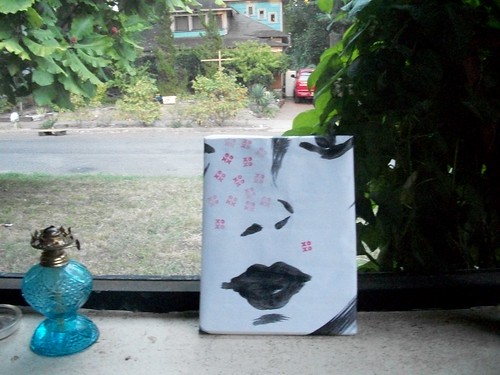
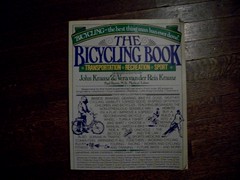
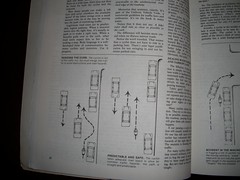
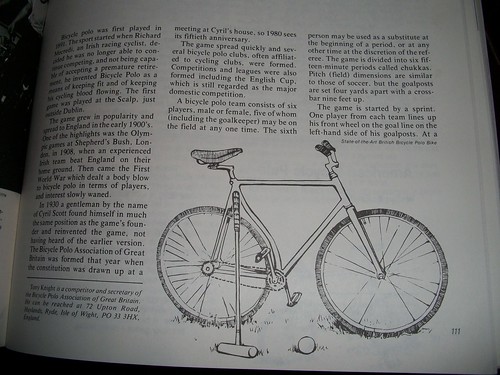
So this book is amazing. Traffic instructions, touring tips, a chapter on cyclocross, chapters entitled 'How to Ride a High-Wheeler' and 'Hurray for Fixed Wheels', British cycle polo vs American cycle polo, and general wind directions per season/city. This coming October the wind direction, according to this book at least, will be pushing towards the west southwest. I guess we'll find out in a few weeks.
I came home this evening and Em was sitting on the porch, watching the neighbor kids skateboard. I jumped over a tie they were setting up for a makeshift box and rolled up the driveway to find that Em had a surprise gift for me, wrapped in her own art.




So this book is amazing. Traffic instructions, touring tips, a chapter on cyclocross, chapters entitled 'How to Ride a High-Wheeler' and 'Hurray for Fixed Wheels', British cycle polo vs American cycle polo, and general wind directions per season/city. This coming October the wind direction, according to this book at least, will be pushing towards the west southwest. I guess we'll find out in a few weeks.
Friday, September 10, 2010
Smoopy's Bike Show and Swap Meet
I saw this posted in the Nashville craigslist. I'm not familiar with Smoopy's but perhaps some of our Nashville friends can fill us in. It looks like it will be an interesting time, which, I believe, is mandatory when you start replacing C's with K's.


Thursday, September 9, 2010
Cyclocrunk Dates
According to reliable sources the dates for Cyclocrunk 2010 are October 12th, 19th, and 26th. Same as last year on time and entry fee, like a good drink: 7 & 7. Still taking place at Tobey Park, with some "surprises."
Cyclocrunk is a non-points series purely for the love of bicycles and beer. Visit cyclocrunk.com for pictures of last years series. The dates there should be updated soon.
Some of my 2009 pictures: Cyclocrunk pictures
Cyclocrunk is a non-points series purely for the love of bicycles and beer. Visit cyclocrunk.com for pictures of last years series. The dates there should be updated soon.
Some of my 2009 pictures: Cyclocrunk pictures
Wednesday, September 8, 2010
Ditch Pictures
Part I: Always be prepared.





I awoke at 8:15 to make sure my light was charged for my first ditch ride (I was out of town for the previous ride); it wasn't. Thankfully I still had an hour or so before Taylor arrived so I plugged it into the charger and set about organizing the rest of my supplies. I was never a Boy Scout but I do like to be prepared: Spare tubes, spare tire, multiple CO2's, batteries, water, knife, headlamp, and a handpump. I didn't have a first aid kit but I know I can always make due with some water, a t-shirt and some electrical tape.
By the time Taylor arrived my light was sufficiently charged and we headed over to Dennis'. They were set up and we made our way to the in-progress greenline.
Even though the line isn't officially open there are plenty of people already enjoying the space. Right when we hopped onto the line a couple passed us on road bikes. They may have been riding 25's but they certainly weren't cross or mountain bikes. The terrain is loose gravel so I'm sure they weren't having as easy a time as we were. Kudos to them; and to the father and son riding extremely slow. I feel bad because I passed them as some other riders were heading our way. I think I scared the dude in front as I cut back across to the right side. I stopped at the entrance and while we were waiting until everyone was out of eyeshot (we didn't want anyone seeing us actually entering the ditch) Dennis thought it would be a good idea to splash me with water. So I think it's a good idea to post this picture of him laughing. Laugh on, crazy face, laugh on.
Part II: Enter the Dragon
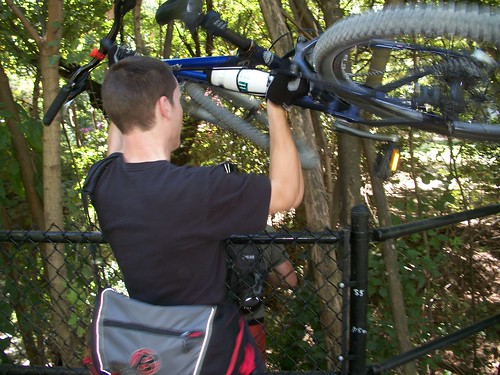

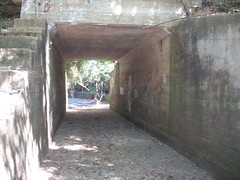
The GPS was no help. No one wanted to wait around long enough for it to find the satellites but we felt confident that with our knowledge of Memphis city streets that we could just poke our heads up and know where we were. We took off riding, ducking and dodging low branches, criss-crossing the small stream by popping wheelies over it where the debris wouldn't allow straight line. We rode for quite a while like this and even ducking through some tunnels, none of which we more that 30 yards long. We could always see the light at the end of the tunnel and none were so low that we uncomfortable riding through. Until we came to one tunnel.
We stopped for a second and poked our heads up to see where we were. We saw a playground and figured we were looking at an area of Poplar. So I figured that when we took this new, longer and lower tunnel we would be riding under campus and come out near Southern. One should never presume anything. Riding through this tunnel proved more difficult the further we went in, not onaccounta debris but for the low ceiling. It got to the point where we were laying on our top tubes, one foot on one pedal and pushing with the other, craning our necks to see where our lights were pointing, calling out pieces of wood and rebar that had been strewn about the floor. We were relieved to come to this one point where we could stand up and stretch. Johnny looked down and found a hammer, recalling earlier exploits in the ditch by Phil, Hal, Bobby, etc... Dennis put it nicely when he said something like, "If I had known we were going to be leaned over for so long I would have stayed in that spot for longer." We rode for quite a while longer, occasionally taking a break, squatting and letting our necks rest. After several 'how much longer's' and a few 'maybe we should turn back's' we saw a light. Thankfully the rebar was loose enough so we could bend it back enough to get our bikes and bodies through.
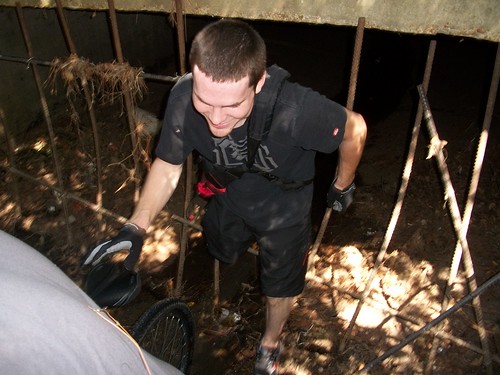
Part III: Urban Trespassing
We rode for a little bit longer and came to an even smaller round tunnel. Time to climb out. Luckily it was fairly easy to get out, though standing on fences proved precarious. We ended up running cross style through someone's back yard and hopping their fence. It was a very 'Ferris Beuller's Day Off' kind of feel, minus girls in bikinis.

Remember how we thought we were going to pull out on Southern? Wrong. We pulled out next to Shady Grove just before a police officer drove down the street. I think being in the dark for that amount of time disturbed our sense of space. We rode down Shady Grove and passed Memphis Thunder on some kind of Labor Day training ride. Maybe it was just a joy ride because they weren't going very fast.

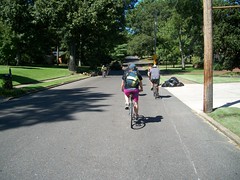
And that's all. We'll let you know the next time we go.





I awoke at 8:15 to make sure my light was charged for my first ditch ride (I was out of town for the previous ride); it wasn't. Thankfully I still had an hour or so before Taylor arrived so I plugged it into the charger and set about organizing the rest of my supplies. I was never a Boy Scout but I do like to be prepared: Spare tubes, spare tire, multiple CO2's, batteries, water, knife, headlamp, and a handpump. I didn't have a first aid kit but I know I can always make due with some water, a t-shirt and some electrical tape.
By the time Taylor arrived my light was sufficiently charged and we headed over to Dennis'. They were set up and we made our way to the in-progress greenline.
Even though the line isn't officially open there are plenty of people already enjoying the space. Right when we hopped onto the line a couple passed us on road bikes. They may have been riding 25's but they certainly weren't cross or mountain bikes. The terrain is loose gravel so I'm sure they weren't having as easy a time as we were. Kudos to them; and to the father and son riding extremely slow. I feel bad because I passed them as some other riders were heading our way. I think I scared the dude in front as I cut back across to the right side. I stopped at the entrance and while we were waiting until everyone was out of eyeshot (we didn't want anyone seeing us actually entering the ditch) Dennis thought it would be a good idea to splash me with water. So I think it's a good idea to post this picture of him laughing. Laugh on, crazy face, laugh on.
Part II: Enter the Dragon



The GPS was no help. No one wanted to wait around long enough for it to find the satellites but we felt confident that with our knowledge of Memphis city streets that we could just poke our heads up and know where we were. We took off riding, ducking and dodging low branches, criss-crossing the small stream by popping wheelies over it where the debris wouldn't allow straight line. We rode for quite a while like this and even ducking through some tunnels, none of which we more that 30 yards long. We could always see the light at the end of the tunnel and none were so low that we uncomfortable riding through. Until we came to one tunnel.
We stopped for a second and poked our heads up to see where we were. We saw a playground and figured we were looking at an area of Poplar. So I figured that when we took this new, longer and lower tunnel we would be riding under campus and come out near Southern. One should never presume anything. Riding through this tunnel proved more difficult the further we went in, not onaccounta debris but for the low ceiling. It got to the point where we were laying on our top tubes, one foot on one pedal and pushing with the other, craning our necks to see where our lights were pointing, calling out pieces of wood and rebar that had been strewn about the floor. We were relieved to come to this one point where we could stand up and stretch. Johnny looked down and found a hammer, recalling earlier exploits in the ditch by Phil, Hal, Bobby, etc... Dennis put it nicely when he said something like, "If I had known we were going to be leaned over for so long I would have stayed in that spot for longer." We rode for quite a while longer, occasionally taking a break, squatting and letting our necks rest. After several 'how much longer's' and a few 'maybe we should turn back's' we saw a light. Thankfully the rebar was loose enough so we could bend it back enough to get our bikes and bodies through.

Part III: Urban Trespassing
We rode for a little bit longer and came to an even smaller round tunnel. Time to climb out. Luckily it was fairly easy to get out, though standing on fences proved precarious. We ended up running cross style through someone's back yard and hopping their fence. It was a very 'Ferris Beuller's Day Off' kind of feel, minus girls in bikinis.

Remember how we thought we were going to pull out on Southern? Wrong. We pulled out next to Shady Grove just before a police officer drove down the street. I think being in the dark for that amount of time disturbed our sense of space. We rode down Shady Grove and passed Memphis Thunder on some kind of Labor Day training ride. Maybe it was just a joy ride because they weren't going very fast.


And that's all. We'll let you know the next time we go.
Sunday, September 5, 2010
Urban Exploration Ride
If you're down to go underground meet up at Dennis and Erica's (Highland and Cowden) tomorrow morning (Monday) at 10am. Be sure to have all of your supplies (flat fixin' kit, backpack, headlamp, etc...) If you have a GPS that will be especially cool as well. If you want more info shoot me a text. 901-921-8096
Subscribe to:
Comments (Atom)
